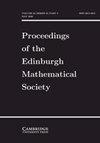On traces of Bochner representable operators on the space of bounded measurable functions
IF 0.7
3区 数学
Q2 MATHEMATICS
Proceedings of the Edinburgh Mathematical Society
Pub Date : 2024-01-11
DOI:10.1017/s0013091523000779
引用次数: 0
Abstract
Let Σ be a σ-algebra of subsets of a set Ω and  $B(\Sigma)$ be the Banach space of all bounded Σ-measurable scalar functions on Ω. Let
$B(\Sigma)$ be the Banach space of all bounded Σ-measurable scalar functions on Ω. Let  $\tau(B(\Sigma),ca(\Sigma))$ denote the natural Mackey topology on
$\tau(B(\Sigma),ca(\Sigma))$ denote the natural Mackey topology on  $B(\Sigma)$. It is shown that a linear operator T from
$B(\Sigma)$. It is shown that a linear operator T from  $B(\Sigma)$ to a Banach space E is Bochner representable if and only if T is a nuclear operator between the locally convex space
$B(\Sigma)$ to a Banach space E is Bochner representable if and only if T is a nuclear operator between the locally convex space  $(B(\Sigma),\tau(B(\Sigma),ca(\Sigma)))$ and the Banach space E. We derive a formula for the trace of a Bochner representable operator
$(B(\Sigma),\tau(B(\Sigma),ca(\Sigma)))$ and the Banach space E. We derive a formula for the trace of a Bochner representable operator  $T:B({\cal B} o)\rightarrow B({\cal B} o)$ generated by a function
$T:B({\cal B} o)\rightarrow B({\cal B} o)$ generated by a function  $f\in L^1({\cal B} o, C(\Omega))$, where Ω is a compact Hausdorff space.
$f\in L^1({\cal B} o, C(\Omega))$, where Ω is a compact Hausdorff space.
论有界可测函数空间上的波克纳可表示算子的踪迹
让 Σ 是一个集合 Ω 的子集的 σ 代数,$B(\Sigma)$ 是 Ω 上所有有界 Σ 可测标量函数的巴纳赫空间。让 $\tau(B(\Sigma),ca(\Sigma))$ 表示 $B(\Sigma)$ 上的自然麦基拓扑。研究表明,当且仅当 T 是局部凸空间 $(B(\Sigma),\tau(B(\Sigma),ca(\Sigma)))$ 和巴拿赫空间 E 之间的核算子时,从 $B(\Sigma)$ 到巴拿赫空间 E 的线性算子 T 才是 Bochner 可表示的。我们推导出了由函数 $f\in L^1({\cal B} o, C(\Omega))$ 生成的波赫纳可表示算子 $T:B({\cal B} o)\rightarrow B({\cal B} o)$ 的迹的公式,其中 Ω 是一个紧凑的豪斯多夫空间。
本文章由计算机程序翻译,如有差异,请以英文原文为准。
求助全文
约1分钟内获得全文
求助全文
来源期刊
CiteScore
1.10
自引率
0.00%
发文量
49
审稿时长
6 months
期刊介绍:
The Edinburgh Mathematical Society was founded in 1883 and over the years, has evolved into the principal society for the promotion of mathematics research in Scotland. The Society has published its Proceedings since 1884. This journal contains research papers on topics in a broad range of pure and applied mathematics, together with a number of topical book reviews.

 求助内容:
求助内容: 应助结果提醒方式:
应助结果提醒方式:


